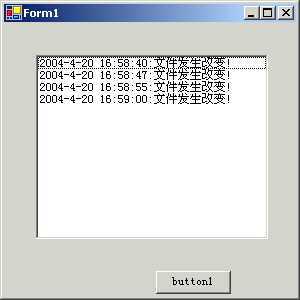标签:
用一个例子来说明事件的使用。
创建一个简单的类,名为FileWatch,包含事件OnfileChange。该类将检查在执行应用程序的目录(当前
目录,通常是项目名/bin/debug)下,是否存在文件test.txt。如果文件被删除或创建,都将触发事件。
同时提供一个方法MonitorFile以不断地查询该文件。
方法:
在创建一个可用事件之前,首先声明一个委托,放在类的外面。
public delegate void FileWatchEventHandler(object sender,EventArgs e);
接下来创建类FileWatch。然后声明事件,注意事件的类型即为我们之前定义的委托。
public event FileWatchEventHandler FileWatchEvent;
现在创建方法OnFileChange(),当调用该方法时将触发事件:
protected virtual void OnFileChange(EventArgs e)
{
if (FileWatchEvent!=null)
{
FileWatchEvent(this,e);
}
}
最后,创建方法MonitorFile(),
public void MonitorFile()
{
bool bCurrentStatus;
while(true)
{
bCurrentStatus = File.Exists("test.txt");
if (bCurrentStatus != _bLastStatus) //_bLastStatus为私有字段,初始值为false;
{
_bLastStatus = bCurrentStatus;
OnFileChange(EventArgs.Empty);
}
Thread.Sleep(250);
}
}
完整代码如下:
using System;
using System.Threading;
using System.IO;
namespace Sample.Event
{
public delegate void FileWatchEventHandler(object sender, EventArgs e);
public class FileWatch
{
private bool _bLastStatus = false;
public FileWatch()
{
//
// TODO: 在此处添加构造函数逻辑
//
}
public event FileWatchEventHandler FileWatchEvent;
protected virtual void OnFileChange(EventArgs e)
{
if (FileWatchEvent != null)
{
FileWatchEvent(this, e);
}
}
public void MonitorFile()
{
bool bCurrentStatus;
while(true)
{
bCurrentStatus = File.Exists("test.txt");
//状态不符,说明文件被删除或重新创建,此时触发事件;
if ( bCurrentStatus != _bLastStatus )
{
_bLastStatus = bCurrentStatus;
OnFileChange( EventArgs.Empty );
}
Thread.Sleep(250);
}
}
}
}
使用:创建一个Windows应用程序来测试我们之前建立的FileWatch中的事件。首先将刚才创建的项目编译
,生成Assembly:FileWatch.dll,然后添加引用。当然直接添加项目引用也可以。然后在Windows应用程
序中加入命名空间:
using Sample.Event;
然后在应用程序类中,定义一个私有字段,类型为我们之前创建的类FileWatch:
public class frmMain : System.Windows.Forms.Form
{
private Sample.Event.FileWatch FileWatchEventSource;
并在构造函数中实例化该对象;
public frmMain()
{
InitializeComponent();
FileWatchEventSource = new Sample.Event.FileWatch();
然后将本地方法OnFileChange连接到事件中:
FileWatchEventSource.FileWatchEvent+=new Sample.Event.FileWatchEventHandler(OnFileChange);
我们需要调用MonitorFile方法来触发事件。在本例中,我们用线程来控制MonitorFile方法。这样可以在
应用程序闲置的时候运行该方法以触发事件。
thrd = new Thread(new ThreadStart(FileWatchEventSource.MonitorFile));
thrd.Start();
最后,我们需要知道事件是否被触发,为了记录下事件触发的历史记录,我们在ListBox控件添加触发内
容。由于事件触发后调用的方法是OnFileChange,因此我们将操作放在该方法里:
private void OnFileChange(object Sender, EventArgs e)
{
listBox.Items.Add(DateTime.Now.ToString()+": 文件发生改变.");
}
当触发事件时,EventHanler会传递sender和EventArgs类的引用。EventArgs类通常是在事件源和触发事
件器之间传递信息。在本例中,没有传递信息,也没有用到EventArgs类。而只是将事件添加到了ListBox
中。
运行结果如下:

结论:在C#中使用事件的要点:
首先,要建立委托,格式为:
public delegate void 委托名(object sender, EventArgs e);
注意:委托即C里的函数指针,在事件中由于要传递事件及触发事件的对象的信息,因此参数表是固定的。委托名一般格式是:名字+EnvenHandle。这样取名比较规范。
然后,建立一个事件字段:
public event 委托类型 事件名;
注意:event关键字代表事件,返回类型为委托;
再定义一个方法,处理事件,再本例中为OnFileChange(EventArgs e)。在该方法中应该调用事件:
事件名(object ,EventArgs);
这里object一般为本身,实参应为this,EventArgs应为OnFileChange中传递过来的实参,尤其是要传递事件的值。
最后还要创建触发事件的方法。例子中为MonitorFile(),在其方法中,当条件满足则调用OnFileChange来达到触发事件的目的。
再使用事件时,通常要定义两个方法,一个是和事件定义的委托签名一致的方法,在本例中为OnFileChange(Object sender,EventArgs e);
注意在例子中,窗体类的OnFileChange和事件类的OnFileChange是不同的。后者用于调用事件,前者则用于绑定事件。绑定事件的方法很简单,用+=表示添加事件,-=表示删除事件。
例子中
FileWatchEventSource.FileWatchEvent+=new Sample.Event.FileWatchEventHandler(OnFileChange);
即为添加事件。
例子中:首先线程启动(thd.Start()),然后调用MonitorFile()方法。引起事件产生,FileWatchEvent产生后,由于我们将事件FileWatchEvent绑定到了OnFileChange()方法上。因而调用本地即窗口类的OnFileChange()方法,从而实现在ListBox中添加信息。
标签:
原文地址:http://www.cnblogs.com/shiningrise/p/5601558.html